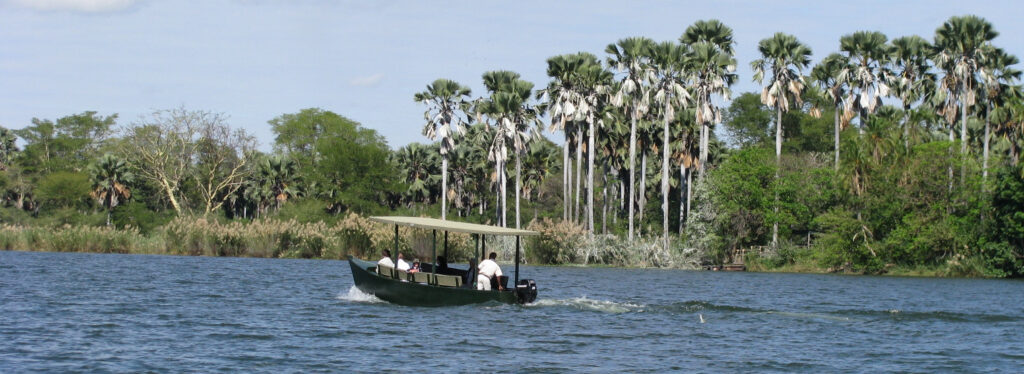
With our breakfast complete we fall in behind our guide and make our way down the long stone path toward waters edge. Our guide’s name is “Danger,” and we are hopeful his name has nothing to do with his ability to successfully navigate the small boat in these crocodile-infested waters. We have seen enough stories about these vicious creatures on the National Geographic and Discovery Channels, and have no desire to have them up close and personal.
It is late July and our team of six has come to the Liwonde Game Park in southern Malawi for a two-day Safari. It is now the morning of the second day, and we are preparing for a boat trip along the giant Shire River. There has not been a drop of rain in this part of Africa since early April. However, this does not appear to have adversely affected the amount of water flowing down the Shire on its long route to the south. The Shire river will eventually join up with the mighty Zambezi and turn east toward its ultimate destination, the Indian Ocean. In most of Malawi the rivers run west to east and then empty into Lake Malawi, the twelfth largest fresh-water lake in the world. Near the southern end of the lake, like a drain plug in a giant bathtub, is the only outlet, the Shire River. The Shire is 250 miles or 402 km long and is the only tributary from the Zambezi that is navigable from the sea. The great explorer, David Livingston, spent most of 1859 exploring this river. In all of his African explorations, Livingston traveled 29,000 miles and added 1 million square miles to the known portion of the globe. Now we were about to embark on the same waterway he had traveled along. A moment of reverent recollection touches us as we walk along the path beside the giant river. To our right, a large baboon watches us as we pass close by. We watch him as well! He could be a real risk.
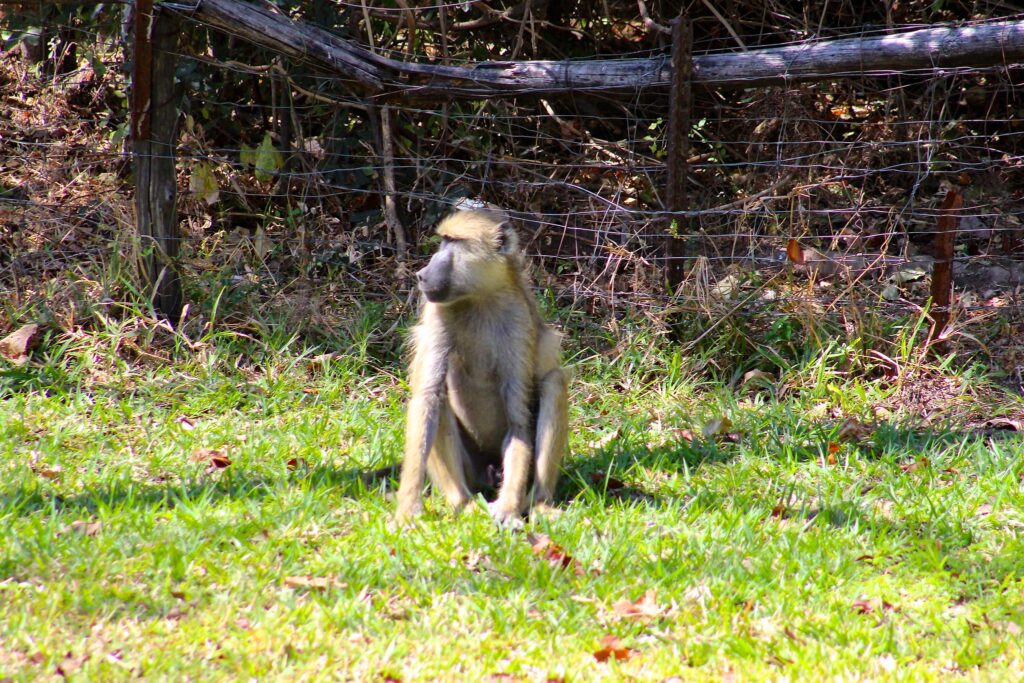
Following the Path of Livingston
We make our way cautiously down the steps and onto the wooden boat dock that extends some 25 feet into the Shire. It sways with our weight. Tied safely to the dock on each side are four small wooden boats capable of carrying about 8 people on the river adventure. Danger helps each person step past the rubber tire buffer and down into the boat. He is careful to suggest that each person sits in such a way as to maintain a reasonable balance to the craft. It sways with each new person stepping into it. After our group is safely positioned, he unties the rope from the dock and tosses it into the front of the boat. Then he steps lightly into the back of the boat and with the same confident motion, he pushes us away from the dock and toward the current of the rapidly moving Shire. A giant crane that had been sitting atop a nearby tree decides to go with us, and he begins a long glide that takes him close to the shoreline.
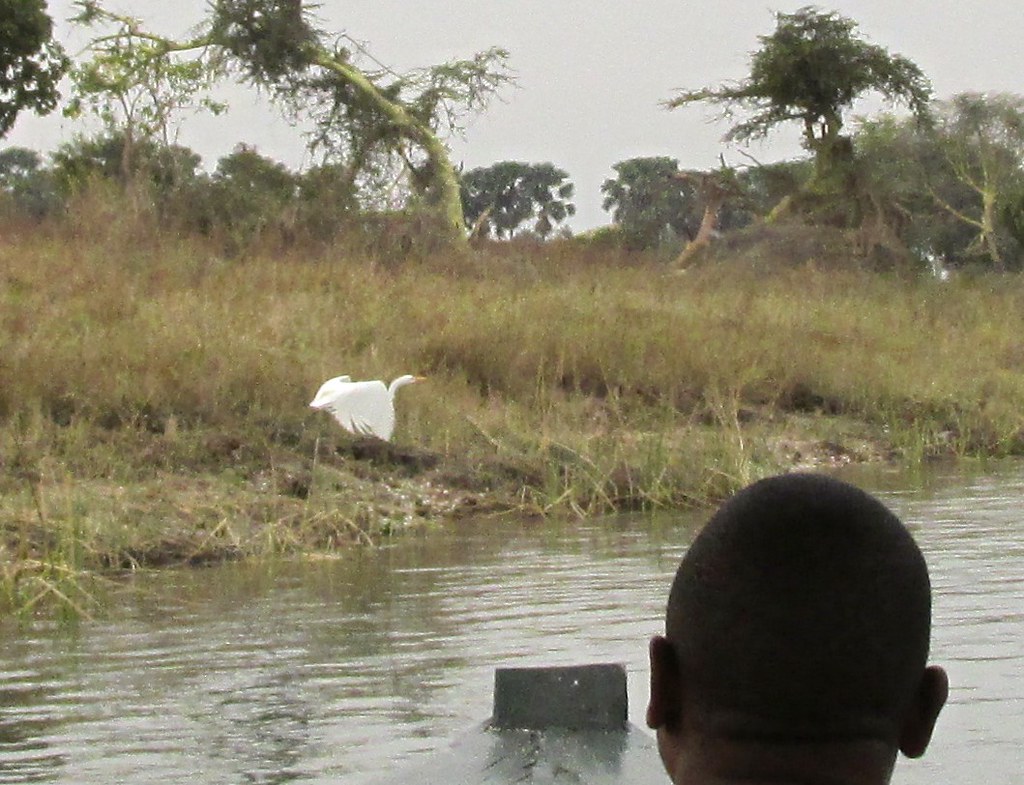
Do Not Stand Up in the Boat
Danger has the full attention of his audience as he begins to give the dos and don’ts of a safe and pleasant journey on the water.
“Do not stand up in the boat. If you do you might fall into the water. If you fall in the water the crocodile may come to visit you. If you fall in the water, I am not authorized to jump in to get you. So sorry,” he says with a slight smile. Then he turns his full attention to our expectations as to what we will see on the river Safari.
“We will see many birds,” he begins. “Along the river, we will see the crocodile and the hippo.” He does not make note of the fact that this stretch of water is reported to hold one of the largest concentrations of hippo pods in this part of Africa.
“We may also see the elephant,” he says, during our next two hours on the water.
The Engine Roars to Life
By now the boat has drifted into the swifter current and Danger turns his attention to the black Suzuki outboard engine. One quick pull on the rope and the engine springs to life as Danger turns the yellow and black wooden boat into the oncoming current. Above us, and attached to the four corners of the boat, the group is sheltered from the early morning sun by the grey canopy. It helps shade our eyes from the intense sunlight and the reflection as we eagerly scan the rippling green water for signs of life anywhere in any direction. The sunlight dances across the water sprinkling dots of light randomly in every direction.
We Head for the Tall Palms
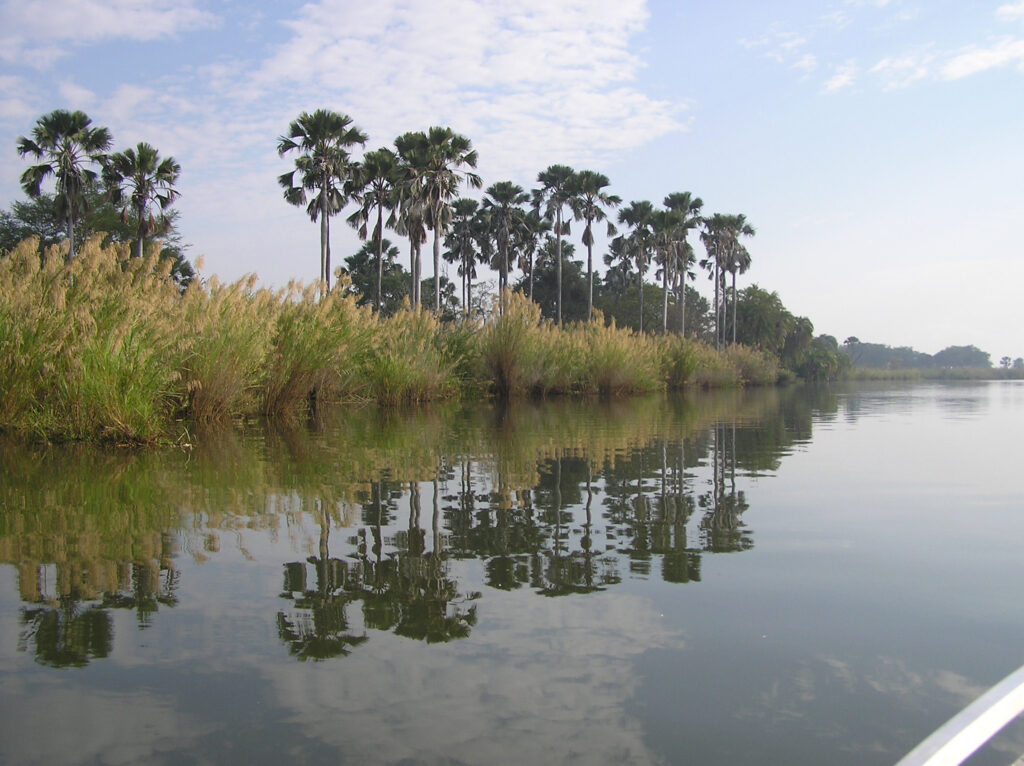
Almost immediately Danger steers the boat toward a group of high palm trees on the west bank. Everyone scans the treetops and observes a large number of birds nesting in the higher branches. Below them, the ground and foliage are covered with the white residue of bird droppings. However, it is not the birds he is headed toward. The danger is directing us to a tiny cove that is almost invisible from the east and from our location which is near the center of the river. Near its entrance is the first pod of hippo we will see along the route. These are the ones that made the snorting sounds we heard much of the previous night at Mvuu Camp and are probably the ones who wandered up into the camp around midnight. Near the rest of the pod are what appears to be a mother, father, and baby hippo. They seem not to notice us as they eat the succulent grass near the river’s edge.
Tiny Ears on Giant Bodies
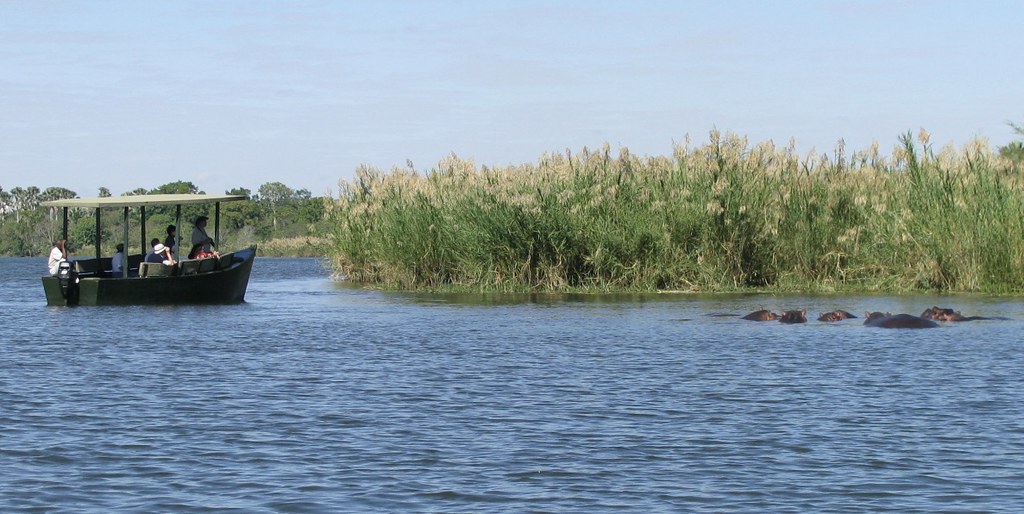
Near the shore, the tiny heads protrude slightly above the water as eyes and ears appear clearly visible just above the waterline. Occasionally a back will appear above the water line or a quick twist of a startled hippo will cause one of them to leap upward out of the water exposing the massive bulk of these creatures. Danger watches them intently. As we approach closer to the pod they drop out of sight under the water line and our guide is careful to avoid what might be their underwater path. The hippopotamus is responsible for more human causalities than any other animal on the continent and a human being will invariably lose if he gets in the path of a fast-moving hippo. Dozing during the daylight hours the hippo seeks a place along the shoreline, or in a pool of water where he can sleep half-submerged in the water. If he remains on land during the sunny daylight hours, he will contract serious sunburn. Thus, it is unusual to see a hippo on land during daylight. At night he will emerge from the water in order to forage for food, sometimes several kilometers away from his watery home. The next day he returns early in the morning to the same place and the same pod. The hippo is very family-oriented and will remain in and around the same home all of his life. All of this and the proximity of the pod to our camp, which again is called “Mvuu” or “Hippo” Camp, explains why we were warned upon arrival not to leave our chalets at night for any reason. Our camp is on the edge of the shoreline and it seems that almost every night the elephants and the hippo come into the camp to eat the grass the custodians try to maintain around the site. Hence the danger is evident if one goes outside in the dark and startles a 2-ton unpredictable, grouchy, fast-moving mammal as he makes a startled dash to get away from the unexpected intruder. He may run over them instead of excusing himself in order to pass on either side.
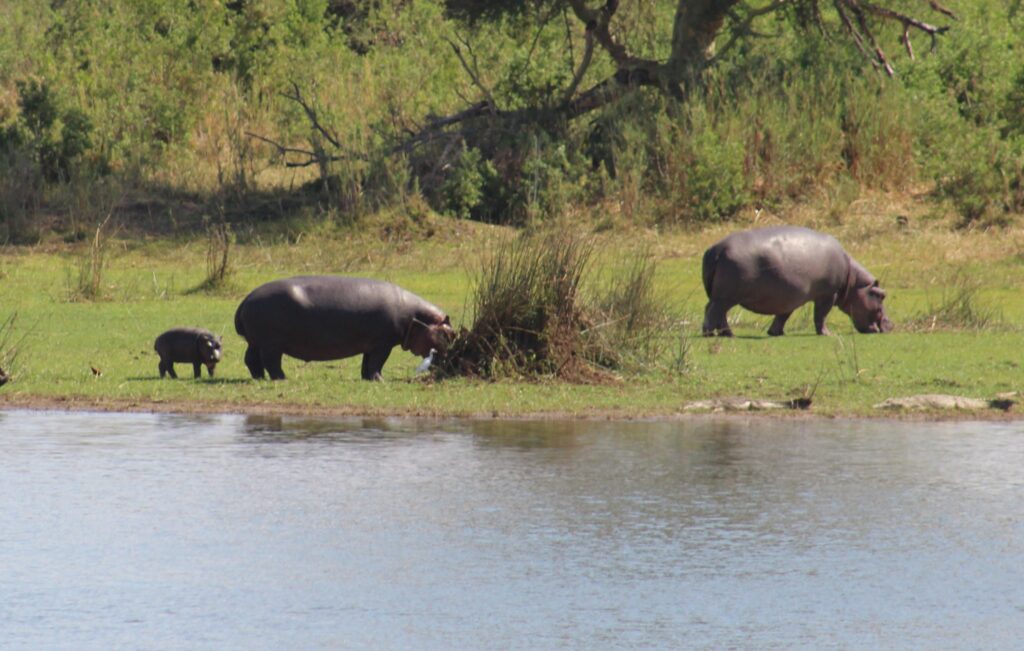
Avoid the Giants Moving into Deeper Water
Danger fully understands the threat and quickly turns into deeper water in order to avoid the giants that are moving unseen under the water. A hippo can hold his breath for several minutes and walk rapidly on the bottom of the river and they are considered even more agile in the water than on land. Our guide’s concern is that one of the submerged hippos will come toward the boat, by mistake or on purpose, to drive us away from the rest of the pod. If he were to come up under the boat or if we were to strike a submerged hippo he could easily capsize the small boat. We move quickly out into the main current and away from the pod.
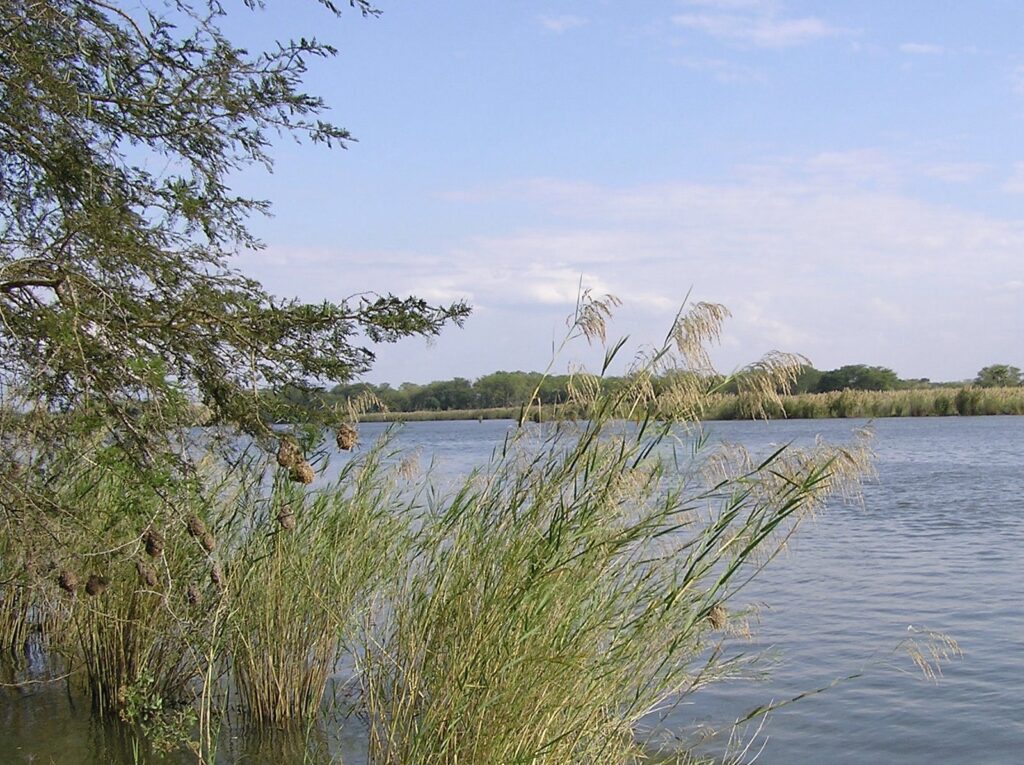
Once past this initial group of hippo pods, that seem to line the entire shoreline, we again glide in closer to the shoreline so Danger can point out a wide array of birds. Some are hovering near mud-encrusted nests that hang precariously on long reeds that stand in the water near the shore. They sway gracefully with each passing wave. These small brown nests camouflage them from their enemies. Hovering ever so close are other birds that seem to flaunt their colors. Beautiful birds that are black on top with white underbellies and redheads make a statement to each passerby. They seem to dance across the sky as though the limbs they land on are too hot for their tiny feet and they must keep moving to keep from burning their toes. Near the top of one of the trees, a majestic eagle seems to admire his domain as he holds his head high.
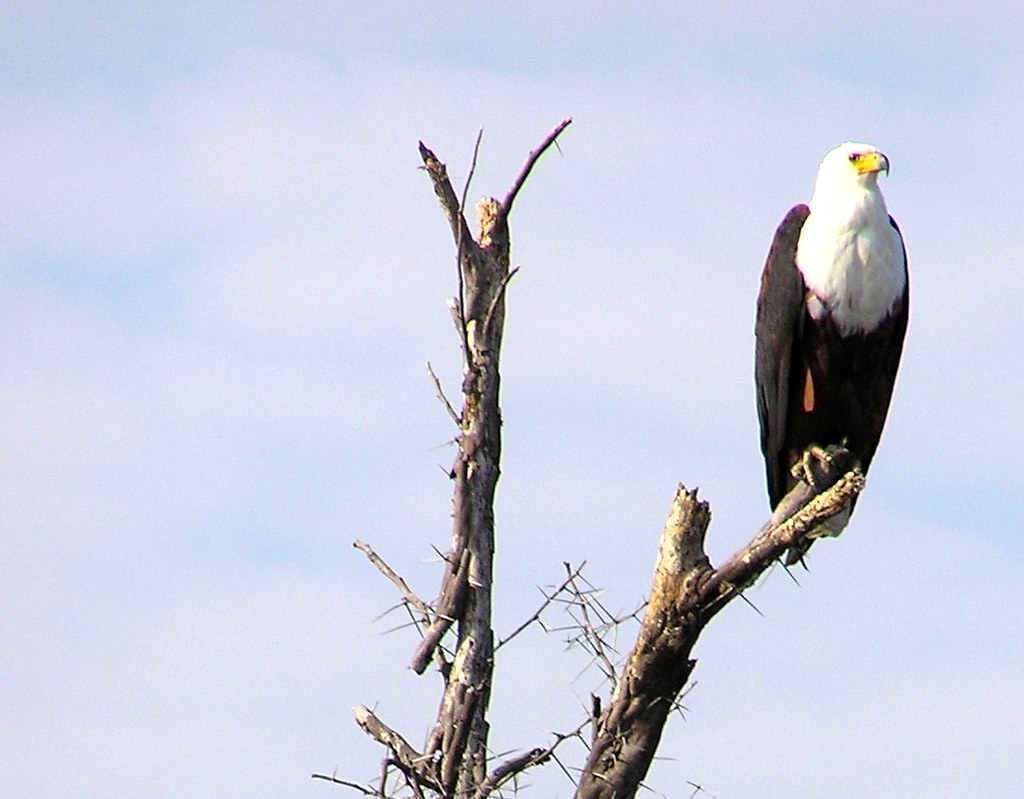
Another Danger Faces Us from the Shore
Then Danger points ahead of us and to the right. For a second no one sees what he is pointing toward. Then it seems everyone sees it at the same moment and the hair on the back of my arm seems to stand a little taller. The giant Nile crocodile is laying down on the bank with his head toward the water. He is four feet from water’s edge with his eyes closed. He seems oblivious to the approaching boat. Our motor is now idling in order to make as little a disturbance as possible, and it seems that everyone is holding his or her breath. The boat closes stealthily toward the rendezvous point where the bow of the boat and a jagged tooth-filled mouth will meet. Inching closer to the giant creature Danger seems destined to live up to his name. A few feet away two smaller crocks slid silently into the water and quickly disappear below the murky surface.
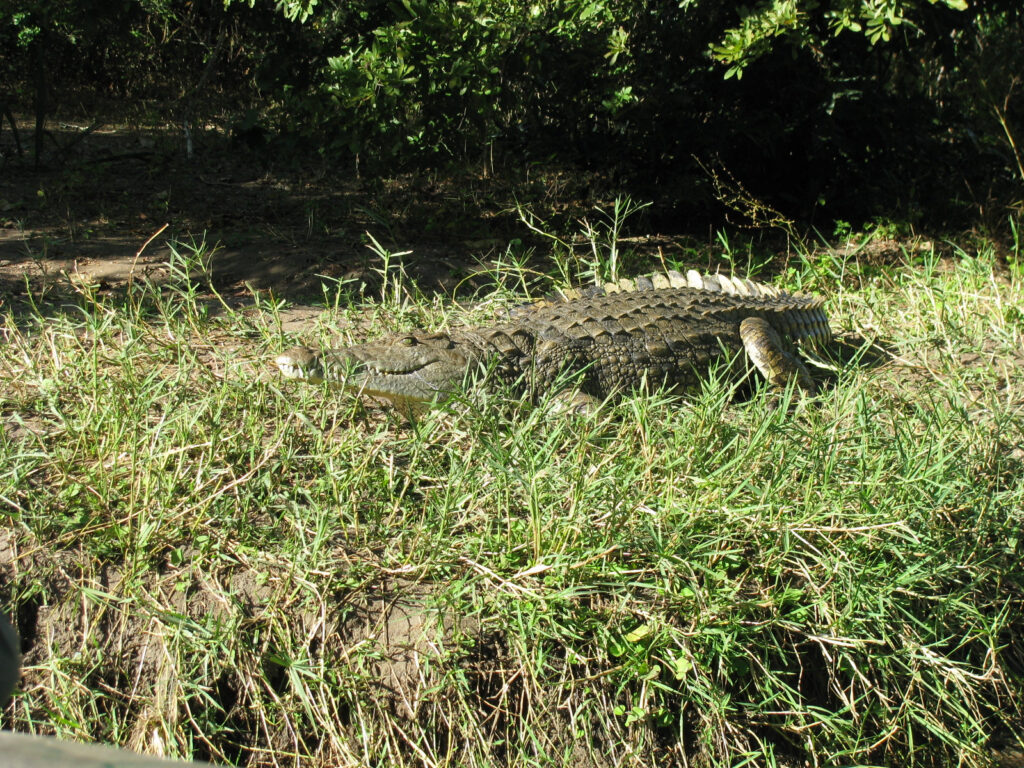
Running silently with the engine off, the boat drifts to within an arm’s length of the shoreline and the crock. At least it appears to be a single arm’s length since no one is willing to extend his or her arm in order to correctly measure the distance. Cameras click and one has to wonder if the sound will arouse this giant who could with a single lunge be sitting next to us in the boat. No reaction. He must be asleep. Maybe. We drift slowly past as Danger indicates this crock is only in his late teens. That doesn’t help much. I’ve raised teens with fewer teeth. They can be pretty dangerous.
A 20-Foot Bag of Murderous Intent
The Nile crocodile can reach lengths of 20 feet. Danger estimates this one is “only” about 15 feet. Only! A safe distance away from this close encounter out in the main channel we observe the heads and eyes of the other two crocks moving rapidly into deeper water and away from the boat. Danger moves us away from them as well. An island near the west bank comes into view and it is literally covered with a large number of crocks. “A convention up ahead,” Danger points out and we hope it is not the members of a crocodile cooking school. Danger points out that a crock eats only fish 99% of the time. “It is only 1% of the time that they eat animals or humans. It is usually for their Christmas Parties,” he adds. No one asks when crock Christmas is held, but his humor has successfully broken the tension.
Here is the Signal, Follow Me
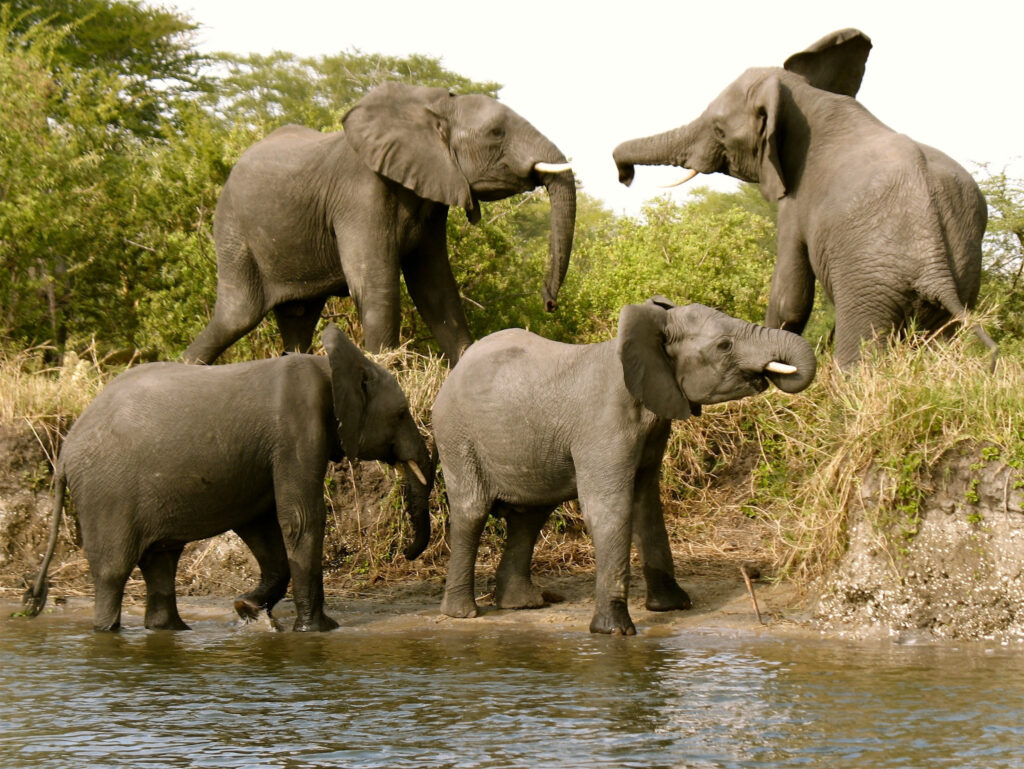
A little way in from the shoreline our passing boat startles two warthogs. They bolt and begin running toward the forest. As they run their tiny tails point straight up in the air as though giving a silent signal to other wart hogs of “here I am, follow me.”
The Giants of the Forest are Close
Then suddenly our guide turns the boat to the right and crosses the main channel. Up a side waterway, he has just seen a number of elephants. It is the moment we have all been waiting for. There is something about the elephant that causes everyone to take a deep breath. They are magnificent, graceful animals and their sense of community holds lessons that even humans should imitate. Reaching the wide entrance, he slows the engine in order for the boat to inch into the shallow water. Reeds line the shore and near the east end of the inlet stand the gentle giants of the forest. We are looking at no less than 50 of the magnificent creatures of the forestlands standing knee-deep in the water. Four of the younger ones are near the bank and seemingly so involved in play they do not even notice us. For a moment everyone is so awestruck that cameras remain untouched as the group tries to take in the scene in front of them. It is certain that no western zoo or any future National Geographic special will ever match this moment. Other elephants appear like a group of preteens on a hot summer day playing in the spray of a giant lawn sprinkler.
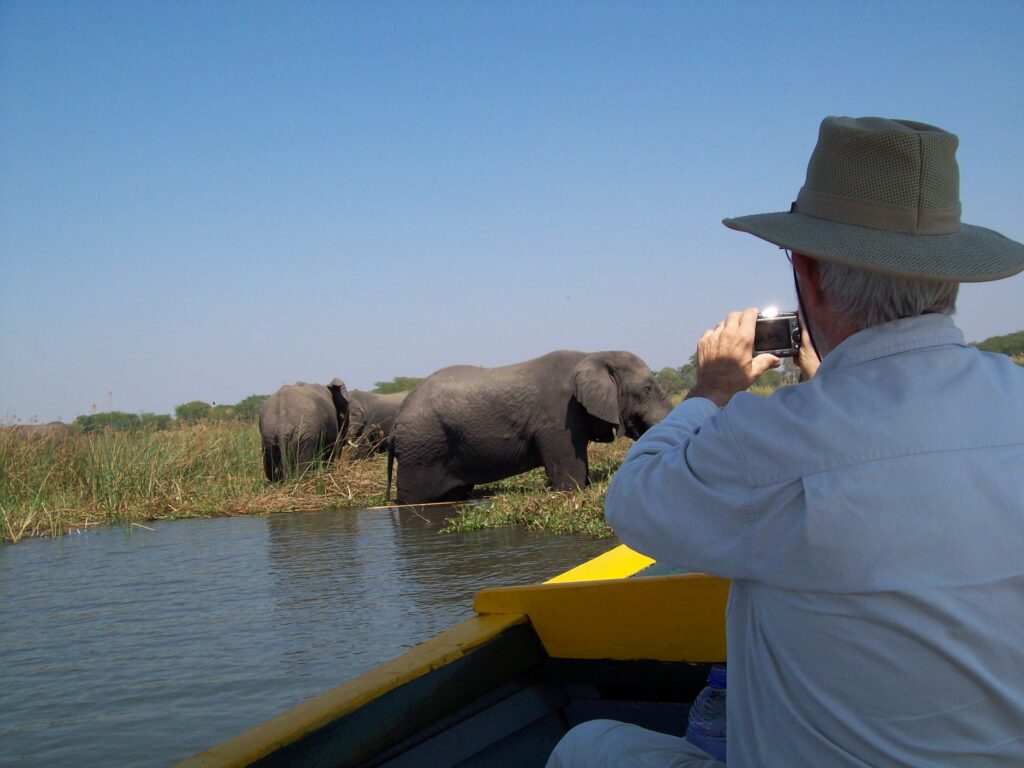
They fill their trunks and then with a sudden swinging action toss the spray up and over their backs. Sort of a jungle shower system. They appear to be having a great time and not at all concerned with the small boat that has entered their river washroom. The boat inches closer to the herd when suddenly one of the smaller elephants, apparently a sentry, turns uneasily toward the approaching boat. He is positioned where he can easily protect the two baby elephants from harm. Some unseen movement or an unheard sound warns the babies and one of them quickly heeds the call to scurry up the bank to escape the intruder. The other one moves behind one of the larger elephants, probably its mother, as she continues to drink water without apparent fear or concern. From the sentry, however, ears flare and he raises his trunk in the air and swings it in threatening gestures. One trumpet from his mighty voice and a chill goes through all of us. The sentry has determined that the boat is close enough. Although the elephant has no intention of moving into deeper water toward us, he does not wish for the boat to move any closer to the herd. Our guide complies with his earthshaking request and reverses the engine. In apparent respect the elephant also turns away, giving the guide the ability to claim that he did not retreat from the field of confrontation in disgrace.
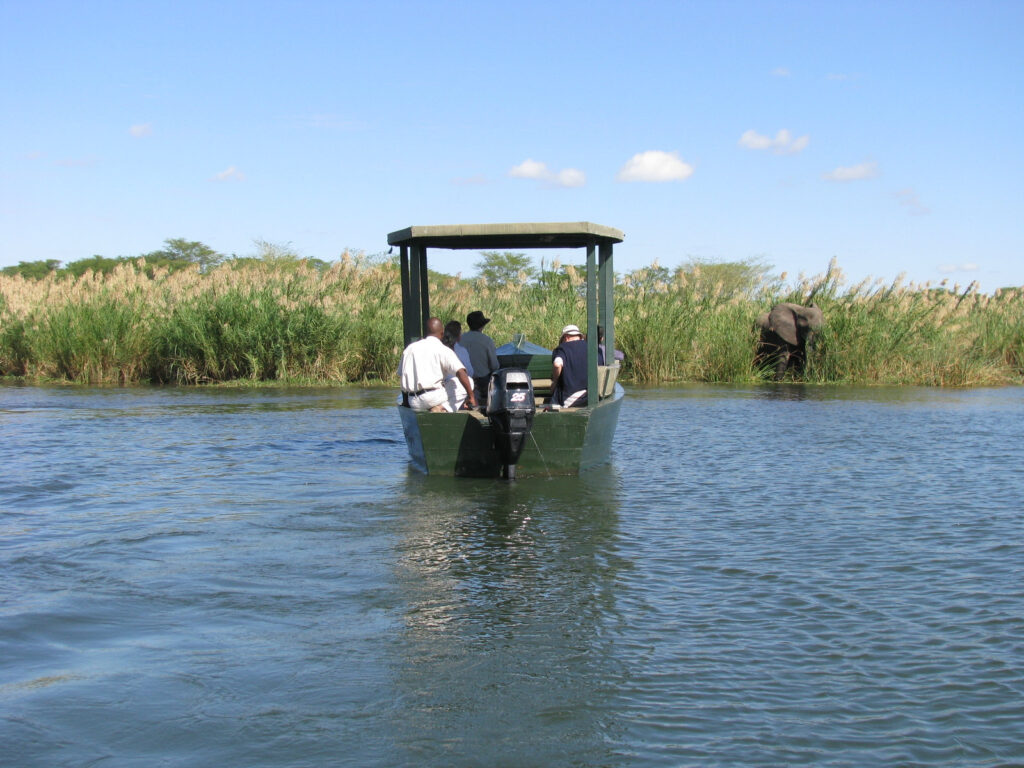
As we continue, we see more crocks, more elephants, and more of the numerous animals and birds that live in this place the same way they have lived for countless ages gone by. As we turn back toward Mvuu Camp we fall in behind the Monkey Bay boat. It sure looks small when it comes to the wildlife we have encountered along the way.
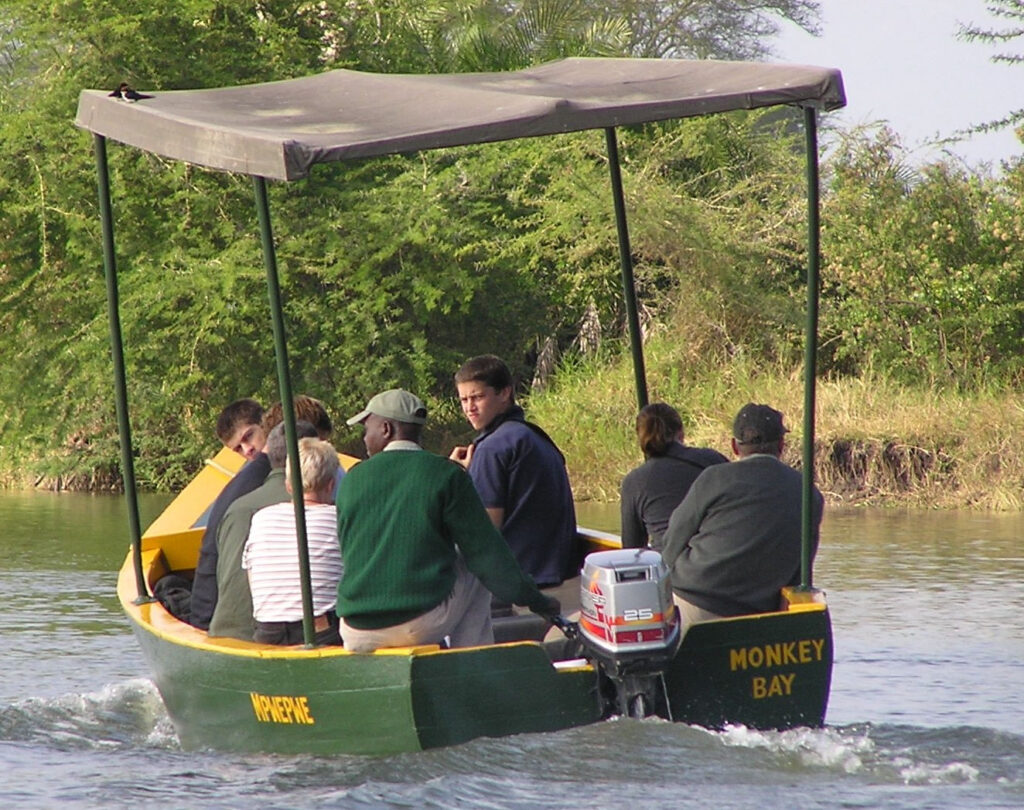
How Long Will it Remain?
The time has raced by and already we are nearing the end of our river trip on the Shire. Danger turns the boat toward the main channel and begins to retrace our way back toward the base camp at Mvuu. It has been a good morning in the sub-Sahara of Africa. Giant white clouds punctuate the morning while the sun continues its dance across the African sky. One must acknowledge this must be the way it has been for thousands of years. And one must also wonder how far this touch of the ancient past will extend unspoiled into the future.
